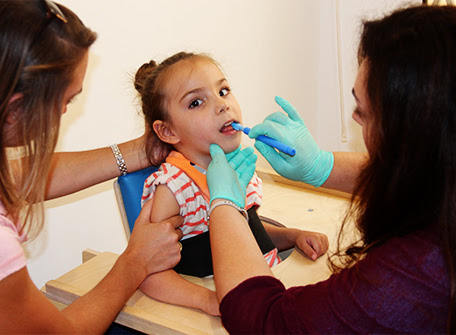Assisting Your Child Toward Success with Feeding Therapy Long Island
Wiki Article
Navigating the Course to Effective Feeding: Cutting-edge Strategies and Treatments for Effective Feeding Therapy
Are you battling to locate effective techniques and interventions for successful feeding therapy? Look no more. This post will lead you via the path to success, offering innovative strategies to examine feeding challenges and established attainable goals. With evidence-based methods, you'll learn just how to deal with sensory processing problems and use assistive innovation and flexible equipment. And also, we'll show you the importance of working together with families and caregivers for optimum feeding results. Prepare yourself to browse the path to effective feeding!Assessing Feeding Obstacles and Recognizing Goals
You must begin by evaluating your kid's feeding challenges and identifying details goals for their treatment. This action is essential in developing an effective feeding treatment plan. Begin by observing your youngster's feeding habits and patterns. Search for any kind of aversions or troubles they may have towards particular foods or structures. Take note of any kind of sensory or physical issues that might be affecting their ability to consume. When you have determined these challenges, you can after that establish specific objectives for their treatment. These goals ought to be possible and reasonable, concentrating on improving your kid's feeding skills and general nutrition. You may set an objective for your youngster to be able to endure a broader range of structures or to self-feed with tools. It is very important to interact these goals with your child's feeding therapist so they can tailor the therapy sessions to resolve these particular difficulties. By evaluating your youngster's feeding difficulties and setting objectives, you are taking the very first step in the direction of aiding them create effective feeding skills.Carrying Out Evidence-Based Methods for Feeding Treatment
Implementing evidence-based techniques for feeding therapy can bring about favorable outcomes for children. When you include these approaches into your child's treatment strategy, you are ensuring that the interventions utilized are sustained by clinical study and have been verified reliable. This technique increases the chance of success and helps deal with the details feeding challenges your child may be experiencing.By following evidence-based strategies, you can give your youngster with the very best feasible care and support. These methods might include using a variety of sensory experiences during mealtimes, such as discovering various appearances and flavors, to encourage approval of brand-new foods. Furthermore, executing therapy methods can assist attend to picky eating habits and advertise much healthier eating patterns.
An additional essential facet of evidence-based feeding treatment is including the family in the therapy procedure. By giving education and learning and support to moms and dads and caretakers, they can play an energetic function in aiding their child get over feeding difficulties. This collaborative approach enhances the performance of treatment and promotes lasting positive modifications in your youngster's eating practices.

Resolving Sensory Handling Issues in Feeding Treatment
Addressing sensory processing issues in feeding therapy can be challenging, however it is necessary for advertising a favorable eating experience for children. When you come across a kid with sensory processing problems during nourishment, it is necessary to understand that their responses to particular appearances, preferences, scents, or also noises are not deliberate (food therapist farmingdale). By recognizing and dealing with these issues, you can aid develop a supportive environment that urges healthy and balanced eating habits
This approach enables the child to end up being familiar with the food and its sensory properties at their very own pace. In addition, supplying a selection of tastes and textures can aid desensitize their sensory system and broaden their food preferences.
Engaging the youngster in sensory play activities can also be beneficial. Motivate them to discover different structures, such as squishing, squeezing, or touching different food things. This can help normalize sensory input and reduce hostilities to particular textures.
One more vital element is providing a organized and tranquil eating setting. Decrease interruptions, such as bright lights or loud sounds, which can overwhelm their detects and prevent their capacity to concentrate on eating. Developing a foreseeable regular and making use of aesthetic schedules can likewise help the kid feel even more secure and in control throughout mealtime.

Utilizing Assistive Technology and Adaptive Tools
Using assistive innovation and adaptive tools can substantially improve the feeding experience for youngsters with sensory processing troubles. Mealtime can be frustrating and tough when you have difficulty with sensory processing. With the right tools, you can make it an extra pleasurable and effective experience.One alternative is using specialized tools and plates created to fit your needs. These tools might have textured manages or a bigger hold, making them simpler to hold and adjust. Plates with separated areas can assist divide various foods and stop them from touching, which can be a source of pain for some kids.
In addition to specialized tools and plates, there are additionally assistive devices that can be utilized throughout feeding. For example, a weighted vest or lap pad can give deep pressure input, assisting to relax and regulate your sensory system. A shaking toothbrush or chewable jewelry can supply dental sensory excitement, making the act of eating more satisfying.
Modern technology can also contribute in enhancing the feeding experience. There are tools and applications available that can supply auditory or click resources visual cues, such as timers or triggers, to aid you stay focused and organized during mealtime.
Working Together With Households and Caregivers for Effective Feeding Results
When collaborating with households and caregivers, you can function with each other to create a supportive and nurturing setting for effective feeding end results. go By entailing family members and caregivers in the feeding therapy process, you can acquire important insights right into the youngster's feeding difficulties, practices, and preferences. feeding therapy farmingdale ny. This cooperation enables a holistic strategy to feeding treatment, addressing not only the physical aspects but also the psychological and mental aspects that might affect a child's feeding capacitiesOne trick element of teaming up with families and caretakers is providing education and learning and training. By outfitting them with expertise and skills, they can actively join the feeding therapy process and sustain the child's progression outside of treatment sessions. This can consist of instructing them feeding techniques, methods for taking care of nourishment habits, and comprehending the importance of uniformity and routine in developing reference healthy eating routines.
In addition, involving families and caretakers in setting goal and treatment preparation ensures that their perspectives and goals for the youngster are thought about. By collaborating, you can establish realistic and attainable objectives that straighten with the family's top priorities and values - food aversion therapy long island. This collective approach cultivates a feeling of possession and empowerment, developing a strong foundation for successful feeding outcomes
Furthermore, open and normal communication with caregivers and families is crucial for efficient cooperation. By maintaining recurring discussion, you can address problems, give assistance, and make necessary modifications to the feeding treatment strategy as needed. This communication additionally enables for sharing progress updates, celebrating achievements, and determining any kind of difficulties or barriers that may emerge.

Final Thought
You have explored numerous approaches and treatments for efficient feeding treatment, such as evaluating challenges, applying evidence-based strategies, dealing with sensory handling issues, and using assistive modern technology. Remember to always stay aggressive and innovative in your approach to feeding treatment.It's essential to communicate these objectives with your youngster's feeding therapist so they can customize the treatment sessions to address these certain challenges.Executing evidence-based methods for feeding therapy can lead to favorable end results for youngsters.Addressing sensory handling issues in feeding therapy can be difficult, yet it is important for advertising a favorable eating experience for youngsters. By entailing households and caregivers in the feeding therapy procedure, you can get beneficial insights into the youngster's feeding choices, obstacles, and behaviors. By outfitting them with understanding and skills, they can actively participate in the feeding therapy procedure and sustain the child's progress outside of therapy sessions.
Report this wiki page